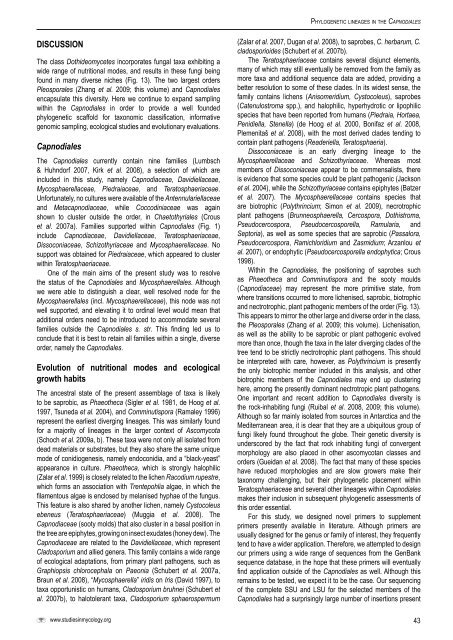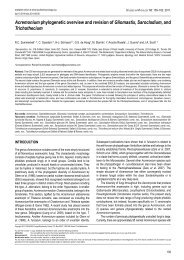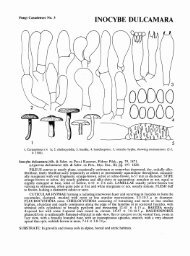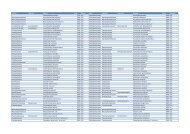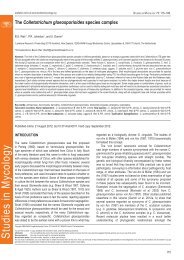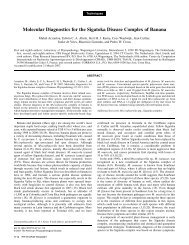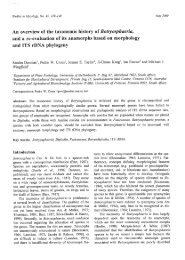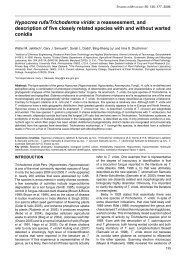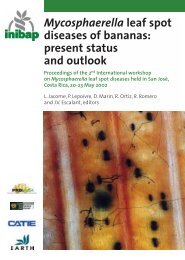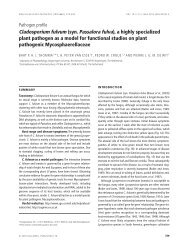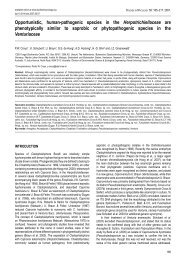Phylogenetic lineages in the Capnodiales - Cbs - KNAW
Phylogenetic lineages in the Capnodiales - Cbs - KNAW
Phylogenetic lineages in the Capnodiales - Cbs - KNAW
Create successful ePaper yourself
Turn your PDF publications into a flip-book with our unique Google optimized e-Paper software.
DIsCUssION<br />
The class Dothideomycetes <strong>in</strong>corporates fungal taxa exhibit<strong>in</strong>g a<br />
wide range of nutritional modes, and results <strong>in</strong> <strong>the</strong>se fungi be<strong>in</strong>g<br />
found <strong>in</strong> many diverse niches (Fig. 13). The two largest orders<br />
Pleosporales (Zhang et al. 2009; this volume) and <strong>Capnodiales</strong><br />
encapsulate this diversity. Here we cont<strong>in</strong>ue to expand sampl<strong>in</strong>g<br />
with<strong>in</strong> <strong>the</strong> <strong>Capnodiales</strong> <strong>in</strong> order to provide a well founded<br />
phylogenetic scaffold for taxonomic classification, <strong>in</strong>formative<br />
genomic sampl<strong>in</strong>g, ecological studies and evolutionary evaluations.<br />
<strong>Capnodiales</strong><br />
The <strong>Capnodiales</strong> currently conta<strong>in</strong> n<strong>in</strong>e families (Lumbsch<br />
& Huhndorf 2007, Kirk et al. 2008), a selection of which are<br />
<strong>in</strong>cluded <strong>in</strong> this study, namely Capnodiaceae, Davidiellaceae,<br />
Mycosphaerellaceae, Piedraiaceae, and Teratosphaeriaceae.<br />
Unfortunately, no cultures were available of <strong>the</strong> Antennulariellaceae<br />
and Metacapnodiaceae, while Coccod<strong>in</strong>iaceae was aga<strong>in</strong><br />
shown to cluster outside <strong>the</strong> order, <strong>in</strong> Chaetothyriales (Crous<br />
et al. 2007a). Families supported with<strong>in</strong> <strong>Capnodiales</strong> (Fig. 1)<br />
<strong>in</strong>clude Capnodiaceae, Davidiellaceae, Teratosphaeriaceae,<br />
Dissoconiaceae, Schizothyriaceae and Mycosphaerellaceae. No<br />
support was obta<strong>in</strong>ed for Piedraiaceae, which appeared to cluster<br />
with<strong>in</strong> Teratosphaeriaceae.<br />
One of <strong>the</strong> ma<strong>in</strong> aims of <strong>the</strong> present study was to resolve<br />
<strong>the</strong> status of <strong>the</strong> <strong>Capnodiales</strong> and Mycosphaerellales. Although<br />
we were able to dist<strong>in</strong>guish a clear, well resolved node for <strong>the</strong><br />
Mycosphaerellales (<strong>in</strong>cl. Mycosphaerellaceae), this node was not<br />
well supported, and elevat<strong>in</strong>g it to ord<strong>in</strong>al level would mean that<br />
additional orders need to be <strong>in</strong>troduced to accommodate several<br />
families outside <strong>the</strong> <strong>Capnodiales</strong> s. str. This f<strong>in</strong>d<strong>in</strong>g led us to<br />
conclude that it is best to reta<strong>in</strong> all families with<strong>in</strong> a s<strong>in</strong>gle, diverse<br />
order, namely <strong>the</strong> <strong>Capnodiales</strong>.<br />
evolution of nutritional modes and ecological<br />
growth habits<br />
The ancestral state of <strong>the</strong> present assemblage of taxa is likely<br />
to be saprobic, as Phaeo<strong>the</strong>ca (Sigler et al. 1981, de Hoog et al.<br />
1997, Tsuneda et al. 2004), and Comm<strong>in</strong>utispora (Ramaley 1996)<br />
represent <strong>the</strong> earliest diverg<strong>in</strong>g <strong>l<strong>in</strong>eages</strong>. This was similarly found<br />
for a majority of <strong>l<strong>in</strong>eages</strong> <strong>in</strong> <strong>the</strong> larger context of Ascomycota<br />
(Schoch et al. 2009a, b). These taxa were not only all isolated from<br />
dead materials or substrates, but <strong>the</strong>y also share <strong>the</strong> same unique<br />
mode of conidiogenesis, namely endoconidia, and a “black-yeast”<br />
appearance <strong>in</strong> culture. Phaeo<strong>the</strong>ca, which is strongly halophilic<br />
(Zalar et al. 1999) is closely related to <strong>the</strong> lichen Racodium rupestre,<br />
which forms an association with Trentepohlia algae, <strong>in</strong> which <strong>the</strong><br />
filamentous algae is enclosed by melanised hyphae of <strong>the</strong> fungus.<br />
This feature is also shared by ano<strong>the</strong>r lichen, namely Cystocoleus<br />
ebeneus (Teratosphaeriaceae) (Muggia et al. 2008). The<br />
Capnodiaceae (sooty molds) that also cluster <strong>in</strong> a basal position <strong>in</strong><br />
<strong>the</strong> tree are epiphytes, grow<strong>in</strong>g on <strong>in</strong>sect exudates (honey dew). The<br />
Capnodiaceae are related to <strong>the</strong> Davidiellaceae, which represent<br />
Cladosporium and allied genera. This family conta<strong>in</strong>s a wide range<br />
of ecological adaptations, from primary plant pathogens, such as<br />
Graphiopsis chlorocephala on Paeonia (Schubert et al. 2007a,<br />
Braun et al. 2008), “Mycosphaerella” iridis on Iris (David 1997), to<br />
taxa opportunistic on humans, Cladosporium bruhnei (Schubert et<br />
al. 2007b), to halotolerant taxa, Cladosporium sphaerospermum<br />
www.studies<strong>in</strong>mycology.org<br />
<strong>Phylogenetic</strong> l<strong>in</strong>eageS <strong>in</strong> <strong>the</strong> <strong>Capnodiales</strong><br />
(Zalar et al. 2007, Dugan et al. 2008), to saprobes, C. herbarum, C.<br />
cladosporioides (Schubert et al. 2007b).<br />
The Teratosphaeriaceae conta<strong>in</strong>s several disjunct elements,<br />
many of which may still eventually be removed from <strong>the</strong> family as<br />
more taxa and additional sequence data are added, provid<strong>in</strong>g a<br />
better resolution to some of <strong>the</strong>se clades. In its widest sense, <strong>the</strong><br />
family conta<strong>in</strong>s lichens (Anisomeridium, Cystocoleus), saprobes<br />
(Catenulostroma spp.), and halophilic, hyperhydrotic or lipophilic<br />
species that have been reported from humans (Piedraia, Hortaea,<br />
Penidiella, Stenella) (de Hoog et al. 2000, Bonifaz et al. 2008,<br />
Plemenitaš et al. 2008), with <strong>the</strong> most derived clades tend<strong>in</strong>g to<br />
conta<strong>in</strong> plant pathogens (Readeriella, Teratosphaeria).<br />
Dissoconiaceae is an early diverg<strong>in</strong>g l<strong>in</strong>eage to <strong>the</strong><br />
Mycosphaerellaceae and Schizothyriaceae. Whereas most<br />
members of Dissoconiaceae appear to be commensalists, <strong>the</strong>re<br />
is evidence that some species could be plant pathogenic (Jackson<br />
et al. 2004), while <strong>the</strong> Schizothyriaceae conta<strong>in</strong>s epiphytes (Batzer<br />
et al. 2007). The Mycosphaerellaceae conta<strong>in</strong>s species that<br />
are biotrophic (Polythr<strong>in</strong>cium; Simon et al. 2009), necrotrophic<br />
plant pathogens (Brunneosphaerella, Cercospora, Dothistroma,<br />
Pseudocercospora, Pseudocercosporella, Ramularia, and<br />
Septoria), as well as some species that are saprobic (Passalora,<br />
Pseudocercospora, Ramichloridium and Zasmidium; Arzanlou et<br />
al. 2007), or endophytic (Pseudocercosporella endophytica; Crous<br />
1998).<br />
With<strong>in</strong> <strong>the</strong> <strong>Capnodiales</strong>, <strong>the</strong> position<strong>in</strong>g of saprobes such<br />
as Phaeo<strong>the</strong>ca and Comm<strong>in</strong>utispora and <strong>the</strong> sooty moulds<br />
(Capnodiaceae) may represent <strong>the</strong> more primitive state, from<br />
where transitions occurred to more lichenised, saprobic, biotrophic<br />
and nectrotrophic, plant pathogenic members of <strong>the</strong> order (Fig. 13).<br />
This appears to mirror <strong>the</strong> o<strong>the</strong>r large and diverse order <strong>in</strong> <strong>the</strong> class,<br />
<strong>the</strong> Pleosporales (Zhang et al. 2009; this volume). Lichenisation,<br />
as well as <strong>the</strong> ability to be saprobic or plant pathogenic evolved<br />
more than once, though <strong>the</strong> taxa <strong>in</strong> <strong>the</strong> later diverg<strong>in</strong>g clades of <strong>the</strong><br />
tree tend to be strictly nectrotrophic plant pathogens. This should<br />
be <strong>in</strong>terpreted with care, however, as Polythr<strong>in</strong>cium is presently<br />
<strong>the</strong> only biotrophic member <strong>in</strong>cluded <strong>in</strong> this analysis, and o<strong>the</strong>r<br />
biotrophic members of <strong>the</strong> <strong>Capnodiales</strong> may end up cluster<strong>in</strong>g<br />
here, among <strong>the</strong> presently dom<strong>in</strong>ant nectrotropic plant pathogens.<br />
One important and recent addition to <strong>Capnodiales</strong> diversity is<br />
<strong>the</strong> rock-<strong>in</strong>habit<strong>in</strong>g fungi (Ruibal et al. 2008, 2009; this volume).<br />
Although so far ma<strong>in</strong>ly isolated from sources <strong>in</strong> Antarctica and <strong>the</strong><br />
Mediterranean area, it is clear that <strong>the</strong>y are a ubiquitous group of<br />
fungi likely found throughout <strong>the</strong> globe. Their genetic diversity is<br />
underscored by <strong>the</strong> fact that rock <strong>in</strong>habit<strong>in</strong>g fungi of convergent<br />
morphology are also placed <strong>in</strong> o<strong>the</strong>r ascomycotan classes and<br />
orders (Gueidan et al. 2008). The fact that many of <strong>the</strong>se species<br />
have reduced morphologies and are slow growers make <strong>the</strong>ir<br />
taxonomy challeng<strong>in</strong>g, but <strong>the</strong>ir phylogenetic placement with<strong>in</strong><br />
Teratosphaeriaceae and several o<strong>the</strong>r <strong>l<strong>in</strong>eages</strong> with<strong>in</strong> <strong>Capnodiales</strong><br />
makes <strong>the</strong>ir <strong>in</strong>clusion <strong>in</strong> subsequent phylogenetic assessments of<br />
this order essential.<br />
For this study, we designed novel primers to supplement<br />
primers presently available <strong>in</strong> literature. Although primers are<br />
usually designed for <strong>the</strong> genus or family of <strong>in</strong>terest, <strong>the</strong>y frequently<br />
tend to have a wider application. Therefore, we attempted to design<br />
our primers us<strong>in</strong>g a wide range of sequences from <strong>the</strong> GenBank<br />
sequence database, <strong>in</strong> <strong>the</strong> hope that <strong>the</strong>se primers will eventually<br />
f<strong>in</strong>d application outside of <strong>the</strong> <strong>Capnodiales</strong> as well. Although this<br />
rema<strong>in</strong>s to be tested, we expect it to be <strong>the</strong> case. Our sequenc<strong>in</strong>g<br />
of <strong>the</strong> complete SSU and LSU for <strong>the</strong> selected members of <strong>the</strong><br />
<strong>Capnodiales</strong> had a surpris<strong>in</strong>gly large number of <strong>in</strong>sertions present<br />
43


